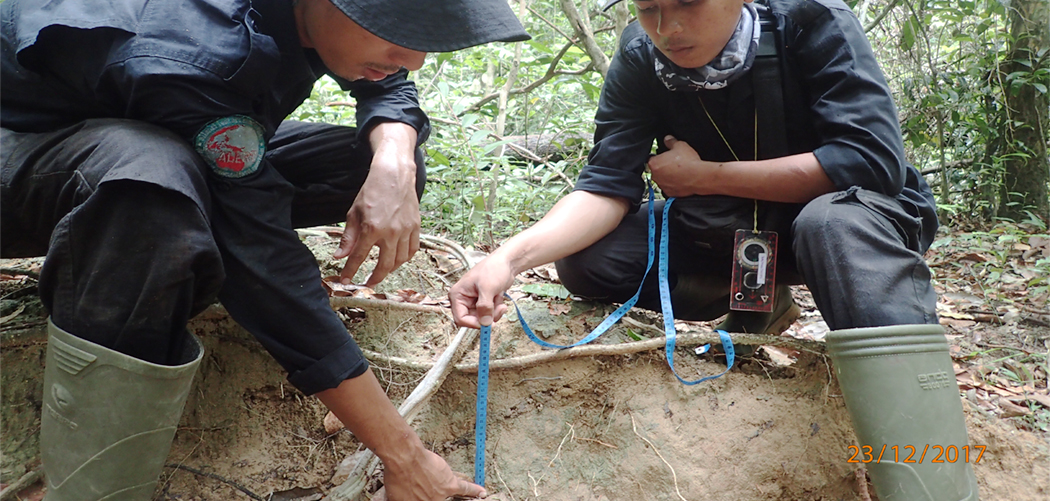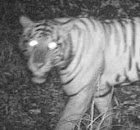
Dry season is the time of forest fire mostly occur. The length of dry season and average temperature, will determine the level of threat of the forest fire. Dry season also known as the time of increasing threat of illegal activity in the Way Kambas National Park. Poaching, bird trapping and illegal fishing, increasing on dry season and many of those activities are directly/indirectly causing forest fire.

There are no evidence of natural factor that has starting forest fire in Way Kambas National Park. In other word, we can say that all forest fire in Way Kambas National Park are human induce fire. A simple mistake like throwing a burning cigarette into the grass, can lead to a disaster. But mostly, forest fire started by an intentional act of illegal activity. Some of the intentions of starting a forest fire by illegal activities are :
- Burning an area of imperata grass so that new fresh grass will grow and attract herbivore to the area.
- Burning thick shrubs to open the area for easier access
- Burning forest as an act of revenge.
- Burning forest to drive away wild elephant.
- Burning forest as a decoy to mobilizing the rangers to a certain spot, while they are aiming to do illegal activity on another spot
More than 90% of forest fire in Way Kambas National Park started from the imperata grass area. Not just the fact that this dry grass is easy to burn, but also their thickness and density has made the forest fire could form a continuous wide wall of fire, creeping and moving fast by the wind. It is therefore important to give priority and extra effort to minimize the threat. With serial consideration of type and factors that causing the forest fire in Way Kambas National Park, “a broad scale of habitat management on imperata grass area should be taken “. It is reasonable to mobilize enough workers to cutting the imperata grass on some of the most threatened location of forest fire, during the right time on the dry season.
- Reducing forest fire fuel
- Reducing fire access (making a fire brake)
- New growing grass providing foods for herbivore. But this require extra protection activity to protect the herbivore from poaching.
- The grass that has been cut can be processed to be compost or cattle food.
- A good program of community involvement
- Cutting the imperata grass will minimize competition of the trees around the area, and increasing the forest succession.
Article and photos by Dicky T. Sutanto
PEMBELAJARAN DARI KEBAKARAN HUTAN
(REFORESTASI BUNGUR 2012)
Selama 3 tahun mengamankan area, pada tanggal 29 September 2012, area reforestasi Bungur mengalami kebakaran hutan. Panas, angin, dan luasnya area alang-alang telah membuat tembok api sepanjang lebih dari 2 km. Sekitar 70% tanaman terbakar pada hari itu. Jelas sebuah bencana.
Musim kemarau adalah waktu dimana kebakaran hutan sering terjadi. Lamanya musim kemarau dan suhu yang konstan akan menentukan tingkat rawan kebakaran hutan. Musim kemarau juga berarti meningkatnya aktivitas illegal di Taman Nasional Way Kambas. Perburuan, perburuan burung, dan memancing liar meningkat sepanjang musim kemarau, dan secara langsung maupun tidak langsung merupakan penyebab kebakaran hutan.
Tidak pernah ada bukti dari penyebab alami kebakaran hutan yang terjadi di Taman Nasional Way Kambas. Dengan kata lain, kebakaran hutan yang terjadi di Taman Nasional Way Kambas terjadi karena ulah manusia. Kesalahan kecil seperti membuang puntung rokok sembarangan bisa menjadi bencana. Tetapi seringkali kebakaran hutan terjadi karena tingginya intensitas aktivitas ilegal. Beberapa tujuan menciptakan kebakaran hutan dari aktivitas ilegal adalah :
- Membakar alang-alang agar tumbuh rumput baru yang memikat satwa herbivora untuk datang
- Membakar semak yang tebal untuk membuka jalan
- Membakar hutan sebagai bentuk dendam
- Membakar hutan untuk menghalau gajah liar
- Membakar hutan untuk menipu petugas menuju ke lokasi tersebut sehingga mereka dapat melakukan kegiatan ilegal ditempat yang lain
Membuat sekat bakar dengan ukuran yang cukup (lebar dan panjang) dapat mengurangi penyebaran kebakaran hutan. Membuat parit juga dinilai efektif namun lebih memakan biaya (mahal) dan pada kondisi tertentu dapat membahayakan satwaliar. Semua itu hanya efektif jika ada petugas yang berada di sekitar lokasi kebakaran.
Memotong/membersihkan alang-alang memiliki beberapa kelebihan yaitu:
- Mengurangi bahan bakar kebakaran hutan
- Mengurangi akses api (membuat sekat bakar)
- Rumput yang baru tumbuh menarik satwa herbivora. Akan tetapi membutuhkan usaha lebih untuk melindungi satwa herbivora dari perburuan
- Sisa potongan rumput bisa dijadikan kompos atau pakan ternak.
- Program yang baik untuk pelibatan masyarakat
- Memotong alang-alang juga mengurangi persaingan pohon disekitar area dan meningkatkan proses suksesi hutan
Dengan perencanaan strategi yang tepat terkait dengan pola, waktu, intensitas dan lokasi pemotongan alang-alang, pembersihan rumput dapat menjadi persiapan terbaik yang dapat dilakukan Taman Nasional Way Kambas untuk mengurangi kebakaran hutan.









































 Enjoy the Way Kambas National Park endangered mega fauna and other rare wildlife species caught in video. Find mother and baby of Sumatran rhino, challenging young male Sumatran tiger, big family of Sumatran elephant, funny Malayan sun-bear and curious Malayan tapir.
Enjoy the Way Kambas National Park endangered mega fauna and other rare wildlife species caught in video. Find mother and baby of Sumatran rhino, challenging young male Sumatran tiger, big family of Sumatran elephant, funny Malayan sun-bear and curious Malayan tapir. It was written by Janos Olah & Attila Simay in Birding Asia magazine, on 2007. Not only the great variety of the otherwise scarce and hard to-come-by species is what makes this national park world-famous, but also the relative ease in finding them. No other place in sumatra that has 4 species of Frogmouth.
It was written by Janos Olah & Attila Simay in Birding Asia magazine, on 2007. Not only the great variety of the otherwise scarce and hard to-come-by species is what makes this national park world-famous, but also the relative ease in finding them. No other place in sumatra that has 4 species of Frogmouth.



0 komentar :
Post a Comment
Berikan saran atau kritik yang membangun untuk website ini
Terimakasih